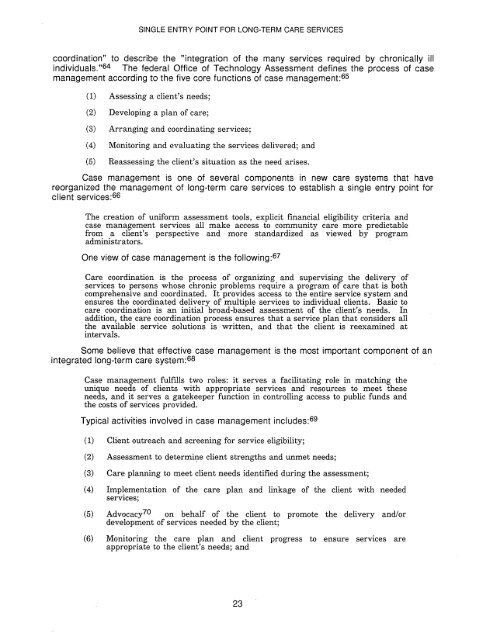long-term care - Legislative Reference Bureau
long-term care - Legislative Reference Bureau
long-term care - Legislative Reference Bureau
Create successful ePaper yourself
Turn your PDF publications into a flip-book with our unique Google optimized e-Paper software.
SINGLE ENTRY POINT FOR LONG-TERM CARE SERVICES<br />
coordination" to describe the "integration of the many services required by chronically ill<br />
individuals. "64 The federal Office of Technology Assessment defines the process of case<br />
management according to the five core functions of case management: 65<br />
(1) Assessing a client's needs;<br />
(2) Developing a plan of <strong>care</strong>;<br />
(3) Arranging and coordinating services;<br />
(4) Monitoring and evaluating the services delivered; and<br />
(5) Reassessing the client's situation as the need arises.<br />
Case management is one of several components in new <strong>care</strong> systems that have<br />
reorganized the management of <strong>long</strong>-<strong>term</strong> <strong>care</strong> services to establish a single entry point for<br />
client services: 66<br />
The creation of uniform assessment tools, explicit financial eligibility criteria and<br />
case management services all make access to community <strong>care</strong> more predictable<br />
from a client's perspective and more standardized as viewed by program<br />
administrators.<br />
One view of case management is the following: 67<br />
Care coordination is the process of organizing and supervismg the delivery of<br />
services to persons whose chronic problems require a program of <strong>care</strong> that is both<br />
comprehensive and coordinated. It provides access to the entire service system and<br />
ensures the coordinated delivery of multiple services to individual clients. Basic to<br />
<strong>care</strong> coordination is an initial broad-based assessment of the client's needs. In<br />
addition, the <strong>care</strong> coordination process ensures that a service plan that considers all<br />
the available service solutions is written, and that the client is reexamined at<br />
intervals.<br />
Some believe that effective case management is the most important component of an<br />
integrated <strong>long</strong>-<strong>term</strong> <strong>care</strong> system: 68<br />
Case management fulfills two roles: it serves a facilitating role in matching the<br />
unique needs of clients with appropriate services and resources to meet these<br />
needs, and it serves a gatekeeper function in controlling access to public funds and<br />
the costs of services provided.<br />
Typical activities involved in case management includes: 69<br />
(1) Client outreach and screening for service eligibility;<br />
(2) Assessment to de<strong>term</strong>iI?-e client strengths and unmet needs;<br />
(3) Care planning to meet client needs identified during the assessment;<br />
(4) Implementation of the <strong>care</strong> plan and linkage of the client with needed<br />
services;<br />
(5) Advocacy70 on behalf of the client to promote the delivery and/or<br />
development of services needed by the client;<br />
(6) Monitoring the <strong>care</strong> plan and client progress to ensure services are<br />
appropriate to the client's needs; and<br />
23
















